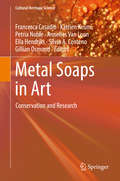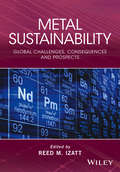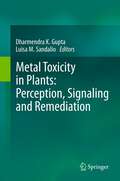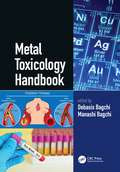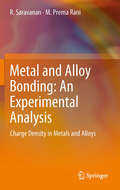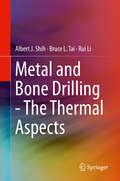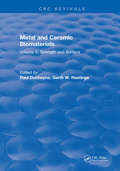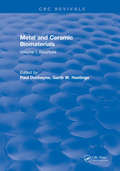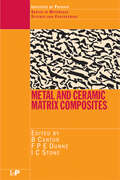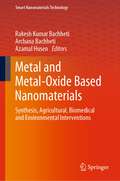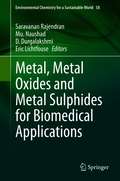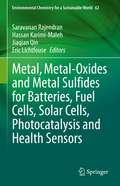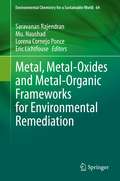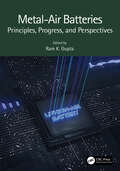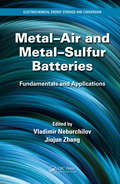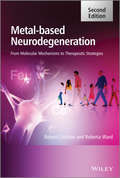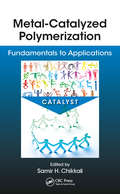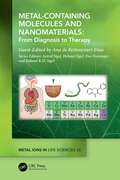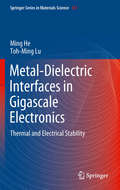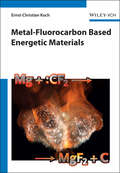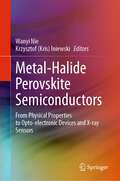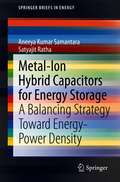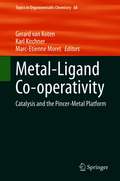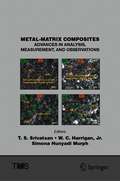- Table View
- List View
Metal Soaps in Art: Conservation and Research (Cultural Heritage Science)
by Francesca Casadio Katrien Keune Petria Noble Annelies Van Loon Ella Hendriks Silvia A. Centeno Gillian OsmondThis go-to reference work surveys the current state of knowledge in the field of metal soap-related degradation phenomena in art works. It contains detailed descriptions and images of the different phenomena and addresses the practical aspects of soap formation, preventive conservation, and treatment.The occurrence of metal soaps is one of the defining issues in the conservation of painted surfaces, and one that presently leaves innumerable open questions. It is estimated that around 70% of paintings in museum collections are affected by some form of metal soap-related degradation. In recent years, significant advances have been made in the detection and characterization of these compounds through interdisciplinary approaches including conventional spectroscopy and microscopy as well as emerging synchrotron-based techniques. This book for the first time captures a panoramic overview of the state of knowledge of metal soaps related to both scientific analysis and implications for conservation and treatment. It also critically examines open questions. The book is accessible to audiences with varied backgrounds (e.g. conservators, students of conservation science) while simultaneously presenting the technical details indispensable for academics and researchers active in this field.
Metal Sustainability: Global Challenges, Consequences, and Prospects
by Reed M. IzattThe sustainable use of natural resources is an important global challenge, and improved metal sustainability is a crucial goal for the 21st century in order to conserve the supply of critical metals and mitigate the environmental and health issues resulting from unrecovered metals. Metal Sustainability: Global Challenges, Consequences and Prospects discusses important topics and challenges associated with sustainability in metal life cycles, from mining ore to beneficiation processes, to product manufacture, to recovery from end-of-life materials, to environmental and health concerns resulting from generated waste. The broad perspective presented highlights the global interdependence of the many stages of metal life cycles. Economic issues are emphasized and relevant environmental, health, political, industrial and societal issues are discussed. The importance of applying green chemistry principles to metal sustainability is emphasized. Topics covered include:* Recycling and sustainable utilization of precious and specialty metals* Formal and informal recycling from electronic and other high-tech wastes* Global management of electronic wastes* Metal reuse and recycling in developing countries* Effects of toxic and other metal releases on the environment and human health* Effect on bacteria of toxic metal release * Selective recovery of platinum group metals and rare earth metals* Metal sustainability from a manufacturing perspective* Economic perspectives on sustainability, mineral development, and metal life cycles* Closing the Loop - Minerals Industry Issues The aim of this book is to improve awareness of the increasingly important role metals play in our high-tech society, the need to conserve our metal supply throughout the metal life cycle, the importance of improved metal recycling, and the effects that unhindered metal loss can have on the environment and on human health.
Metal Toxicity in Plants: Perception, Signaling and Remediation
by Dharmendra K. Gupta Luisa M. SandalioHeavy metal accumulation in soil and water from natural sources or anthropogenic activities have produced severe environmental contamination in some parts of the world due to the persistence of metals in the environment by their accumulation throughout the food chain. The purpose of this book is to present the most recent advances in this field, mainly concerning the uptake and translocation of heavy metals in plants, mechanisms of toxicity, perception of metal and regulation of cell response under metal stress. Another key feature of this book is related to the studies on signaling and remediation processes in recent years, which have taken advantage of recent technological advances including "omic" approaches. In recent years transcriptomic, proteomic and metabolomic studies have become very important tools for analyzing both the dynamics of changes in gene expression and the profiles of protein and metabolites under heavy metal stress. This information is also very useful for plotting the complex signaling and metabolic network induced by heavy metals, in which hormones and reactive oxygen species (ROS) also play an important role. Understanding the mechanism involved in sequestration and hyperaccumulation is very important to developing new strategies of phytoremediation, which are reviewed in several chapters of this book. The information included yields very stimulating insights into the mechanism involved in the regulation of plant responses to heavy metals, which in turn improve our knowledge of cell regulation under metal stress and the use of plants for phytoremediation.
Metal Toxicology Handbook
by Debasis Bagchi and Manashi BagchiHeavy metals and metalloids, singly or in combination, induce toxic manifestations either through acute or chronic pathology. In particular, long-term chronic exposure to diverse heavy metals and metalloids to humans and animals can lead to numerous physical, muscular, neurological, nephrological, and diverse degenerative diseases and dysfunctions, including multiple sclerosis, muscular dystrophy, Parkinson’s and Alzheimer’s diseases, cardiovascular disorders, and several others. Recognized heavy metals such as lead, mercury, arsenic, cadmium, thallium, and hexavalent chromium are known for enormous toxicity. The immediate vital signs of acute heavy metal exposure include nausea, vomiting, diarrhea, and acute abdominal pain. Mercury has been identified as the most toxic heavy metal, and mercury poisoning is known as acrodynia or pink disease. Similarly, lead, another toxic heavy metal, was at one time an integral part of painting. Metal Toxicology Handbook further explains and discusses the varying attributes of metals, discussing toxicity, safety, and proper human utilization of metals. Beginning with a broad overview of metals, metalloids, redox biology, and neurodegeneration and going further into the roles, benefits, and toxicity of metals with each section, the text contains 28 chapters from eminent researchers and scientists in their respective fields and is a must-have for anyone researching the potential toxicity in metals. Key Features Discusses the pathology of metal toxicity Highlights the benefits of metals Explains the mechanism and salient features of restoring metabolic homeostasis Highlights dose-dependent beneficial and adverse effects of vanadium safety and toxicity The initial introductory section provides a broad overview of metals, metalloids, redox biology, and neurodegeneration. The second section discusses the pathology of metal toxicity in two chapters, while the third section highlights the mechanism and salient features of restoring metabolic homeostasis in two chapters. The fourth section demonstrates the aspect of radionuclides toxicity. In a change of pace, the fifth section discusses the benefits of metals in four chapters. The sixth section, titled "Toxic Manifestations by Diverse Heavy Metals and Metalloids," provides fourteen chapters that discuss the toxicological mechanism and manifestation of individual metals. The editors have crafted a commentary titled "A Treatise on Metal Toxicity" and summarized a vivid scenario of metal toxicity and its consequences.
Metal and Alloy Bonding - An Experimental Analysis
by M. Prema Rani R. SaravananCharge density analysis of materials provides a firm basis for the evaluation of the properties of materials. The design and engineering of a new combination of metals requires a firm knowledge of intermolecular features. Recent advances in technology and high-speed computation have made the crystal X-ray diffraction technique a unique tool for the determination of charge density distribution in molecular crystal. Methods have been developed to make experimental probes capable of unraveling the features of charge densities in the intra- and inter-molecular regions of crystal structures. In Metal and Alloy Bonding - An Experimental Analysis, the structural details of materials are elucidated with the X-ray diffraction technique. Analyses of the charge density and the local and average structure are given to reveal the structural properties of technologically important materials. Readers will gain a new understanding of the local and average structure of existing materials. The electron density, bonding, and charge transfer studies in Metal and Alloy Bonding - An Experimental Analysis contain useful information for researchers in the fields of physics, chemistry, materials science, and metallurgy. The properties described in these studies can contribute to the successful engineering of these technologically important materials.
Metal and Bone Drilling - The Thermal Aspects
by Rui Li Albert J. Shih Bruce L. TaiThis book introduces state-of-the-art experimental and numerical methods and examples for evaluating the drilling performance of engineering and biological materials, particularly in thermal aspects. The authors use a common pathway to present the technological and analytical methods for both industry (metal) drilling and orthopaedic surgery (bone) drilling research, making this book a resource for both industrial and clinical readers who wish to understand the evolution of technologies, techniques and challenges in drilling. The authors also focus on advanced engineering materials, such as titanium alloys and high-strength cast irons, which have broad applications in the automotive, aerospace, medical device and sports industries. This book is a must-read for a broad audience, including engineering students in upper-level undergraduate and graduate courses that involve machining processes; for surgery residents, fellows, and practicing surgeons; and for engineers in the medical device industry who develop new bone cutting tools.Bridges the knowledge on drilling from the manufacturing industry to healthcare;Covers the experimental and modeling aspects of drilling thermal analysis;Includes experimental studies that contain parameters and data that emulate practical production and clinical drilling.
Metal and Ceramic Biomaterials: Volume I: Structure
by DucheyneThe understanding of the in vivo performance of synthetic materials is largely dependent upon a profound knowledge of the properties of the materials in question. Analogous to materials science in its broadest sense, the basis for biomaterials science is formed by microstructural there. It is therefore, that in this series on structure property relationships in biomaterials a substantial part is devoted to the analysis of the basic properties of the various synthetic biomaterials. In addition, the effect of microstructural aspects on properties is considered at great length.
Metal and Ceramic Biomaterials: Volume II: Strength and Surface
by DucheyneThe understanding of the in vivo performance of synthetic materials is largely dependent upon a profound knowledge of the properties of the materials in question. Analogous to materials science in its broadest sense, the basis for biomaterials science is formed by microstructural there. It is therefore, that in this series on structure property relationships in biomaterials a substantial part is devoted to the analysis of the basic properties of the various synthetic biomaterials. In addition, the effect of microstructural aspects on properties is considered at great length.
Metal and Ceramic Matrix Composites (Series in Materials Science and Engineering)
by Brian Cantor Fionn Dunne Ian StoneWith contributions from leading experts in their respective fields, Metal and Ceramic Matrix Composites provides a comprehensive overview of topics on specific materials and trends. It is a subject regularly included as a final year option in materials science courses and is also of much industrial and academic interest. The book begins wit
Metal and Metal-Oxide Based Nanomaterials: Synthesis, Agricultural, Biomedical and Environmental Interventions (Smart Nanomaterials Technology)
by Azamal Husen Rakesh Kumar Bachheti Archana BachhetiThe book in hand, namely “Metal and Metal-Oxide Based Nanomaterials (Synthesis, Agricultural, Biomedical and Environmental Interventions”, focuses on the synthesis methods, characterization techniques, and diverse interventions utilizing these nanomaterials in the fields of agriculture, biomedicine, and environmental remediation. The specific applications discussed include food packaging, post-harvest disease management, crop production, drug delivery systems, other biomedical applications, photocatalytic degradation of environmental pollutants, and wastewater treatment. Additionally, it also addresses the potential risks associated with zinc nanoparticles in aquatic ecosystems and emphasizes the importance of further research and regulation in this field. Overall, the book provides valuable insights and serves as a comprehensive resource for researchers and scientists across various interdisciplinary subjects. It serves as a valuable resource for scientists, researchers, and students in nanotechnology, nanomedicine, environmental science, plant science, agriculture, chemistry, biotechnology, pharmacognosy, pharmaceuticals, industrial chemistry, and other interdisciplinary subjects. Moreover, this also inspires further research, innovation, and the development of sustainable solutions for a better future.
Metal, Metal Oxides and Metal Sulphides for Biomedical Applications (Environmental Chemistry for a Sustainable World #58)
by Eric Lichtfouse Mu. Naushad Saravanan Rajendran D. DurgalakshmiThis book presents recent advances in inorganic nanomaterials for healthcare, with focus on the synthesis, medical applications and toxicity of metals, metal oxides and metal sulfides. Major applications include diagnosis, bioimaging, biosensing, healing and therapy in cancer, diabetes, cardiovascular diseases, obesity, metabolic syndrome, dentistry and antimicrobials.
Metal, Metal-Oxides and Metal Sulfides for Batteries, Fuel Cells, Solar Cells, Photocatalysis and Health Sensors (Environmental Chemistry for a Sustainable World #62)
by Eric Lichtfouse Saravanan Rajendran Jiaqian Qin Hassan Karimi-MalehThis book summarizes recent findings on the use of new nanostructured materials for biofuels, batteries, fuel cells, solar cells, supercapacitors and health biosensors. Chapters describe principles and how to choose a nanomaterial for specific applications in energy, environment and medicine.
Metal, Metal-Oxides and Metal-Organic Frameworks for Environmental Remediation (Environmental Chemistry for a Sustainable World #64)
by Eric Lichtfouse Mu. Naushad Saravanan Rajendran Lorena Cornejo PonceThis book reviews principles, techniques and applications of metal, metal oxides, metal sulfides and metal-organic frameworks for removal and degradation of pollutants. Natural materials are often much more advanced than synthetic materials in terms of circularity and are functional, often biodegradable, recyclable and generate little waste. They are, therefore, a source of inspiration for new synthetic materials. In particular, recent research has focused on various types of functional materials such as organic, inorganic, nanostructured and composites for the remediation of environmental pollution.
Metal-Air Batteries: Principles, Progress, and Perspectives
by Ram K. GuptaMetal-Air Batteries: Principles, Progress, and Perspectives covers the entire spectrum of metal-air batteries, their working principles, recent advancement, and future perspectives. Leading international researchers address materials design, electrochemistry, and architectural aspects. The fundamentals of metal-air materials for cathode and anode, their synthetic approaches, chemistries to modify their properties to provide high energy and power densities, along with long life and stable electrochemical characteristics are detailed. Key Features: Covers materials, chemistry, and technologies for metal-air batteries. Reviews state-of-the-art progress and challenges in metal-air batteries Provides fundamentals of the electrochemical behavior of various metal-air batteries. Offers insight into tuning the properties of materials to make them suitable for metal-air batteries. Provides new direction and a better understanding to scientists, researchers, and students working in diverse fields. This is a unique offering and a valuable resource for a wide range of readers including those in academia and industries worldwide.
Metal-Air and Metal-Sulfur Batteries: Fundamentals and Applications (Electrochemical Energy Storage and Conversion)
by Vladimir Neburchilov and Jiujun ZhangMetal–air and metal–sulfur batteries (MABs/MSBs) represent one of the most efficient-energy storage technologies, with high round trip efficiency, a long life cycle, fast response at peak demand/supply of electricity, and decreased weight due to the use of atmospheric oxygen as one of the main reactants. This book presents an overview of the main MABs/MSBs from fundamentals to applications. Recent technological trends in their development are reviewed. It also offers a detailed analysis of these batteries at the material, component, and system levels, allowing the reader to evaluate the different approaches of their integration. The book provides a systematic overview of the components, design, and integration, and discusses current technologies, achievements, and challenges, as well as future directions. Each chapter focuses on a particular battery type including zinc–air batteries, lithium–air batteries, aluminum–air batteries, magnesium–air batteries, lithium–sulfur batteries, and vanadium–air redox flow batteries, and metal–sulfur batteries. Features the most recent advances made in metal–air/metal–sulfur batteries. Describes cutting-edge materials and technology for metal–air/metal–sulfur batteries. Includes both fundamentals and applications, which can be used to guide and promote materials as well as technology development for metal–air/metal–sulfur batteries. Provides a systematic overview of the components, design, and integration, and discusses current technologies, achievements, and challenges, as well as future directions. Covers a variety of battery types in depth, such as zinc–air batteries, lithium–air batteries, aluminum–air batteries, magnesium–air batteries, lithium–sulfur batteries, vanadium–air redox flow batteries, and metal–sulfur batteries.
Metal-Based Neurodegeneration
by Robert Crichton Roberta WardNeurodegenerative diseases of the human brain appear in various forms, resulting in disorders of movement and coordination, cognitive deterioration and psychiatric disturbances. Many of the key factors leading to neurodegenerative diseases are similar, including the dysfunction of metal ion homeostasis, redox-active metal ions generating oxidative stress, and intracellular inclusion bodies.Metal-based Neurodegeneration presents a detailed survey of the molecular origins of neurodegenerative diseases. Each chapter is dedicated to a specific disease, presenting the latest scientific findings, including details of their biochemical actors (proteins or peptides), their normal and pathological conformations, and a description of the diseases characteristics, with an emphasis on the role of metal-induced oxidative stress, which can result in the production of intracellular aggregates of target proteins and peptides. Topics covered include:Brain function, physiology and the blood-brain barrierImmune system and neuroinflammationAging and mild cognitive impairment, MCIParkinson's DiseaseAlzheimer's DiseaseCreutzfelt-Jakob and related prion diseasesAlcoholic Brain DamageTherapeutic strategies to combat the onset and progression of neurological diseasesThis extensively updated, full colour, second edition of Metal-based Neurodegeneration is an essential text for research scientists and clinicians working in gerontology, neuropathology, neurochemistry, and metalloprotein mechanisms.
Metal-Catalyzed Polymerization: Fundamentals to Applications
by Samir H. Chikkali, Ashootosh V. Ambade, Bas de Bruin and Michael ShaverThe proposed book focusses on metal mediated/catalyzed “controlled/living radical polymerization” (CRP/LRP) methods. It surveys a wide variety of catalyzed polymerization reactions, making it essentially a “one stop” review in the field. A significant contribution to polymer science is “metathesis polymerization” discovered by Grubbs and others. The book will cover various metathesis polymerization methods and implications in polymer industry.
Metal-Containing Molecules and Nanomaterials: From Diagnosis to Therapy (ISSN)
by Astrid Sigel Helmut Sigel Eva Freisinger Bettencourt-Dias, Ana de Sigel, Roland K. O.Since the discovery and successful deployment of salvarsan to treat syphilis, as well as cisplatin as a cancer drug, the field of metallodrugs has been flourishing. In addition to therapeutic applications, metals and metal-containing molecules have properties, such as an electrochemical or an optical signal, that can be used to diagnose biologically relevant molecules or unravel cellular metabolism. Moreover, metals are part of the essential elements for life, and of increased attention in nutraceuticals. Most of the current diagnosis processes, therapeutics, and nutraceuticals are based on organic molecules. MILS-26 reviews in 7 comprehensive chapters, written by 20 experienced authors, the most recent metal-containing molecules and nanomaterials for diagnosis and therapy.Features: The field of metallodrugs has been flourishing and this area of research can be used to diagnose specific biologically relevant molecules or unravel cellular metabolism. The authors are preeminent bioinorganic and medicinal inorganic chemists and review the most current research in this field. The book discusses the properties and therapeutic applications of metals and metal-containing molecules including the use of electrochemical or optical signal for diagnosis of biologically relevant molecules. It endorses and stimulates research in the vibrant field of biological inorganic chemistry. It reviews the most current research supporting the relevance of metal-containing molecules and nanomaterials for diagnosis and therapy.
Metal-Dielectric Interfaces in Gigascale Electronics
by Toh-Ming Lu Ming HeMetal-dielectric interfaces are ubiquitous in modern electronics. As advanced gigascale electronic devices continue to shrink, the stability of these interfaces is becoming an increasingly important issue that has a profound impact on the operational reliability of these devices. In this book, the authors present the basic science underlying the thermal and electrical stability of metal-dielectric interfaces and its relationship to the operation of advanced interconnect systems in gigascale electronics. Interface phenomena, including chemical reactions between metals and dielectrics, metallic-atom diffusion, and ion drift, are discussed based on fundamental physical and chemical principles. Schematic diagrams are provided throughout the book to illustrate interface phenomena and the principles that govern them. Metal-Dielectric Interfaces in Gigascale Electronics provides a unifying approach to the diverse and sometimes contradictory test results that are reported in the literature on metal-dielectric interfaces. The goal is to provide readers with a clear account of the relationship between interface science and its applications in interconnect structures. The material presented here will also be of interest to those engaged in field-effect transistor and memristor device research, as well as university researchers and industrial scientists working in the areas of electronic materials processing, semiconductor manufacturing, memory chips, and IC design.
Metal-Fluorocarbon Based Energetic Materials
by Ernst-Christian KochMetal-Fluorocarbon Based Energetic Materials This exciting new book details all aspects of a major class of pyrolants and elucidates the progress that has been made in the field, covering both the chemistry and applications of these compounds. Written by a pre-eminent authority on the subject from the NATO Munitions Safety Information Analysis Center (MSIAC), it begins with a historical overview of the development of these materials, followed by a thorough discussion of their ignition, combustion and radiative properties. The next section explores the multiple facets of their military and civilian applications, as well as industrial synthetic techniques. The critical importance of the associated hazards, namely sensitivity, stability and aging, are discussed in detail, and the book is rounded off by an examination of the future of this vital and expanding field.The result is a complete guide to the chemistry, manufacture, applications and required safety precautions of pyrolants for both the military and chemical industries.From the preface:“... This book fills a void in the collection of pyrotechnic literature... it will make an excellent reference book that all researchers of pyrolants and energetics must have...” Dr. Bernard E. Douda, Dr. Sara Pliskin, NAVSEA Crane, IN, USA
Metal-Halide Perovskite Semiconductors: From Physical Properties to Opto-electronic Devices and X-ray Sensors
by Krzysztof Kris Iniewski Wanyi NieThis book will provide readers with a good overview of some of most recent advances in the field of technology for perovskite materials. There will be a good mixture of general chapters in both technology and applications in opto-electronics, Xray detection and emerging transistor structures. The book will have an in-depth review of the research topics from world-leading specialists in the field. The authors build connections between the materials’ physical properties to the main applications such as photovoltaics, LED, FETs and X-ray sensors. They also discuss the similarities and main differences when using perovskites for those devices.
Metal-Ion Hybrid Capacitors for Energy Storage: A Balancing Strategy Toward Energy-Power Density (SpringerBriefs in Energy)
by Satyajit Ratha Aneeya Kumar SamantaraRapid growth in the research and development of clean energy storage techniques has yielded a significant number of electrochemically active compounds/materials possessing enormous potential to facilitate the fabrication of next generation devices such as the supercapacitor. This Brief describes recent progress in the field of metal-ion based hybrid electrical energy storage devices, with emphasis on the effect of different metal ions and other constituent components on the overall electrochemical performance of battery-supercapacitor hybrids (BSHs). Although significant efforts have been made to create an effective electrical energy storage system that would have the energy density of a battery and the power density of a supercapacitor, persistent challenges still lie in combining these two altogether different systems to form a cost-effective and safe storage device. Detailed comparisons of output performance and longevity (in terms of cyclic stability) are provided, including device fabrication cost and safety.Of the several proposed schematics/prototypes, hybrid supercapacitors, with both carbon-based EDLC electrode and pure faradic (battery type) electrode can work in tandem to yield high energy densities with little degradation in specific power. As a promising electric energy storage device, supercapacitors address several critical issues in various fields of applications from miniaturized electronic devices and wearable electronics to power hungry heavy automobiles. Depending on the electrode configuration and other controlling parameters, these BSHs can have contrasting performance statistics. Metal ion BSHs such as Li+, Na+, Mg+2, Zn+2 etc., acid-alkaline BSHs, and redox electrolyte based BSHs all represent recent approaches, with BSHs based on metal ions, particularly Lithium, of particular interest because of the extreme popularity of Li-ion based batteries. This book is written for a broad readership of graduate students and academic and industrial researchers who are concerned with the growth and development of sustainable energy systems where efficient and cost-effective storage is key.
Metal-Ligand Co-operativity: Catalysis and the Pincer-Metal Platform (Topics in Organometallic Chemistry #68)
by Gerard Van Koten Marc-Etienne Moret Karl KirchnerThis book provides researchers in the fields of organic chemistry, organometallic chemistry and homogeneous catalysis with an overview of significant recent developments in the area of metal-ligand cooperativity, with a focus on pincer architectures. The various contributions highlight the widespread impact of M–L co-operativity phenomena on modern organometallic chemistry and catalyst development. The development of efficient and selective catalytic transformations relies on the understanding and fine control of the various elementary reactions that constitutes a catalytic cycle. Co-operative ligands, which actively participate in bond making and bond breaking together to the metal they support, open up new avenues in this area. In particular, buttressing a weak or reactive metal-ligand bond by flanking coordinating arms in a pincer ligand design is proving a versatile strategy to access robust metal complexes that exhibit unusual and selective reactivity patterns.
Metal-Matrix Composites: Advances in Analysis, Measurement, and Observations (The Minerals, Metals & Materials Series)
by T. S. Srivatsan W. C. Harrigan Jr. Simona Hunyadi MurphThis collection brings together engineers, scientists, scholars, and entrepreneurs to present their novel and innovative contributions in the domain specific to metal-matrix composites and on aspects specific to modeling, analysis, measurements, and observations specific to microstructural advances. Topics include but are not limited to: · Metals and metal-matrix composites · Nano-metal based composites · Intermetallic-based composites Contributions in the above topics connect to applications in industry-relevant areas: automotive, energy applications, aerospace, failure analysis, biomedical and healthcare, and heavy equipment and machinery.
Metal-Matrix Composites: Advances in Processing, Characterization, Performance and Analysis (The Minerals, Metals & Materials Series)
by Pradeep K. Rohatgi T. S. Srivatsan Simona Hunyadi MurphThis collection brings together engineers, scientists, scholars, and entrepreneurs to present their novel and innovative contributions in the domain specific to metal-matrix composites and on aspects specific to processing, characterization, mechanical behavior, measurements, failure behavior, and kinetics governing microstructural influences on failure by fracture. Topics include but are not limited to: • Metals and metal-matrix composites • Nano-metal based composites • Intermetallic-based composites Contributions in the above topics connect to applications in industry-relevant areas: automotive; nuclear and clean energy; aerospace; failure analysis; biomedical and healthcare; and heavy equipment, machinery, and goods.
